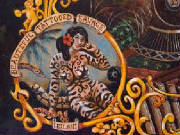|

Circuses began hiring tattooed people, mostly Indians and Polynesians to display in their sideshows,
juggling acts and sword swallowing acts. The attraction would draw huge crowds in both Europe and America.
|
|
|

The first tattoo shop was opened by Martin Hilderbrandt, a German immigrant, on Chatham
Square in New York City making him the first professional tattoo artist in the United States. His main clientele at
that time were soldiers from both sides of the Civil War.
|
|
|

The demand for patriotic designs grew as the Civil War enlisted thousands of men into the Union
Army. Matrin Hilderbrandt was known as the primary artist at the time since he was allowed to easily cross between both
the Confederate and the Union sides of the war.
|
|
|

The first electric tattoo machine was invented and patented by Samuel O'Reilly, an Irish immigrant.
This made the process affordable for lower classes, causing the upper class to turn away from the art which resulted in the
loss of credibility for tattooing.
|
|
|

Tattooing was forced underground as it became socially unacceptable in America. Heavily tattooed
people had to travel with circuses and "freak shows" to earn a living.
|
|
|

One of the fathers of American tattooing, Norman "Sailor Jerry" Collins is noted as
the most famed to have ever lived. He learned the art while traveling the country via freight trains. After his
time in the Navy and visiting Asia, he became fixated on Asian art. He later settled in Hawaii where he practiced his
art for 40 years on passing military men. He was a mentor to people like Don Ed Hardy and Mike Malone.
|
|
| |
Next
|
| |
|
| |
|
| |
|
| |
|
| |
|
| |
|
| |
|
| |
|
| |
|
| |
|
| |
|
| |
|
| |
|

